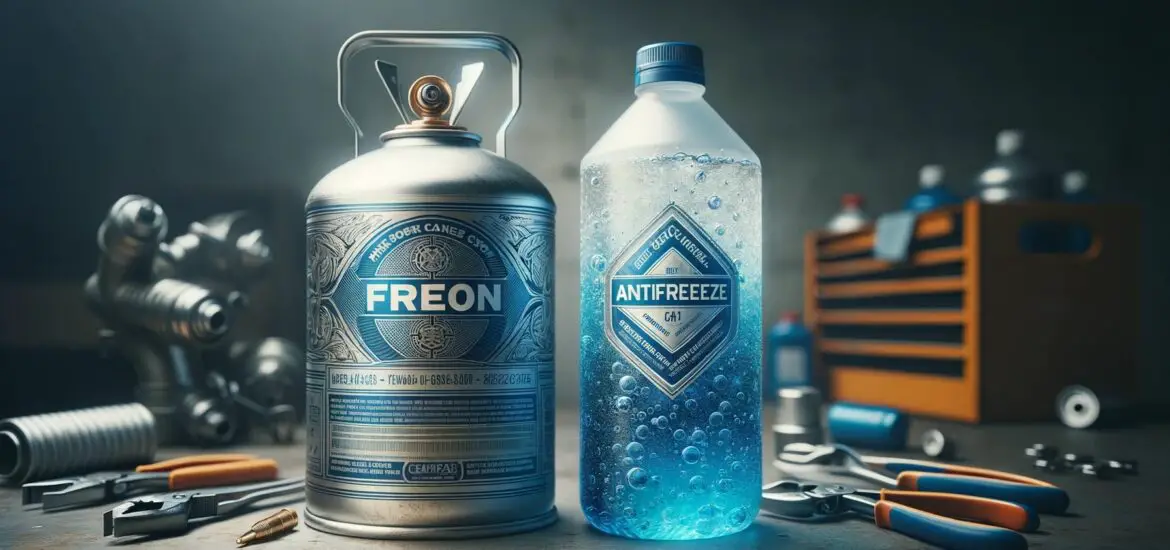Understanding the difference between Freon and coolant is pivotal for those involved in automotive or appliance maintenance and repair. This in-depth guide will clarify each component’s primary use, characteristics, and importance.

Table of Contents
What is Freon?
Freon, initially introduced to the world as a revolutionary refrigerant, has become synonymous with refrigeration and cooling. The term “Freon” is a trademark of the Chemours Company and refers to a variety of halocarbon products.
The primary function of Freon is to serve as a medium for transferring heat. In appliances like air conditioners and refrigerators, Freon absorbs heat from the inside and releases it outside, creating a cooling effect.
Freon belongs to a category of chemicals called chlorofluorocarbons (CFCs). Over the decades, scientists discovered that CFCs, when released into the atmosphere, have a destructive effect on the ozone layer.
This discovery led to international agreements like the Montreal Protocol to phase out their use. As a result, newer versions of Freon, more environmentally benign, have been developed as alternatives.
What is Coolant?
When you think of engines, you might picture them burning with heat. Coolant, also commonly known as antifreeze, prevents this picture from becoming a reality. It’s a fluid that ensures a car’s engine doesn’t get too hot or too cold, maintaining it at an optimal temperature for performance and longevity.
The primary components of coolant are water and chemical compounds like ethylene glycol or propylene glycol. These chemicals lower the freezing point of the coolant (hence the name “antifreeze”) and raise its boiling point, ensuring the engine can function in extreme conditions.
Furthermore, coolants contain additives that prevent corrosion, rust, and foam while enhancing lubrication. Depending on the formulation and its intended use, coolants come in a variety of colors, from green and orange to pink and blue. Each color typically corresponds to a specific formulation suited for various engine types and materials.
Difference between Freon and Coolant
Both Freon and coolant are vital in their respective domains, but they serve vastly different purposes.
Purpose
Freon’s main job is to absorb heat from one location (like the inside of a refrigerator or a room) and release it in another (usually outside). Coolant, in contrast, circulates through a vehicle’s engine, absorbing excessive heat and dispelling it via the radiator to ensure the engine remains at its optimal temperature.
Composition
Freon is primarily composed of chlorofluorocarbons (CFCs) or hydrochlorofluorocarbons (HCFCs) in newer variants. Coolant is a mix of water and chemicals such as ethylene glycol or propylene glycol, combined with additives for protection against corrosion, rust, and other potential issues.
Environmental Impact
Older Freon types, especially CFCs, harm the ozone layer when released into the atmosphere. Coolants, if not disposed of properly, can contaminate the environment, proving toxic for plants, animals, and aquatic life.
Applications
Freon finds its primary use in air conditioning and refrigeration systems, while coolant is essential for automotive engines to function correctly.
Why It’s Important to Know the Difference
Knowledge of the differences between Freon and coolant is not trivial; it’s practical and can have significant implications. Using one in place of the other can lead to severe malfunctions and damage. For instance, if you were to pour coolant into an air conditioning system or vice versa, the results would be disastrous.
Beyond potential equipment damage, safety is paramount. Coolant is toxic when ingested, posing a risk to pets, children, and wildlife. Freon, especially in its gaseous form, can be harmful when inhaled and can cause skin irritations upon contact.
By understanding each substance’s distinct characteristics and uses, you can ensure proper handling, optimize equipment functionality, and prioritize safety.